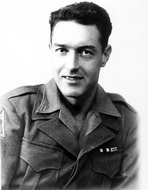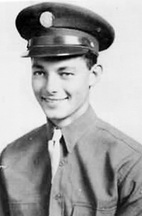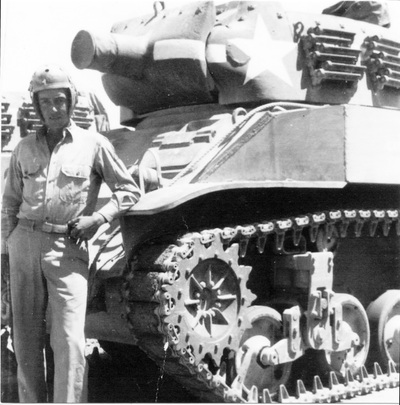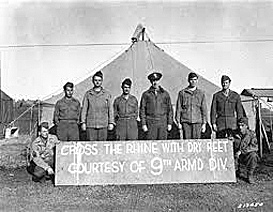 Walter Bagley
Walter Bagley In late October of 2014, my wife, Becky, and I watched the movie "Fury" starring Brad Pitt. The story was about a tank crew in WWII. I knew my dad was a tank driver in the 9th Armored Division during the war.
Growing up, my dad told me some stories, but he didn't talk a lot about the war. Even as a kid I admired my dad, and I wanted to be a soldier like him and serve my country. I became a paratrooper in the 325th Infantry 82nd Airborne Division from 1969 to 1971. Watching the movie sparked my interest to learn more about my dad's part in WWII. My dad died 36 years ago, so I began searching the internet about him and the war.
 Bobby Cobb
Bobby Cobb Doing a further search I found out that Bobby was living with his wife, Louise in Guthrie, Oklahoma. I found his number and called. After that we were in steady contact, and soon I was making arrangements to go to Guthrie to meet them and hear some stories of the time he and my dad spent together.
In the first part of February, this year, my wife and I arrived in Guthrie, OK to pay a visit to Bobby Cobb, now 91 years old, and his wife of 69 years, Louise. I wanted to hear first hand some of the stories of their time together as a tank crew. Bobby's memory is truly remarkable. I was amazed as he was telling me of their many adventures during the time of war, both good and bad.
This is a short story of the part my father, Walter Bagley,of Shunk, PA, and his tank crew, including tank commander, Bobby Cobb, played in the war and the Ludendorff Bridge at Remagen, Germany.
My dad's story starts out like most of the young men at the time. Being drafted in January of 1941, he was sent to Fort Riley, Kansas to the Cavalry Replacement Center (the old horse cavalry). Within in a few months they received jeeps, half-tracks and motorcycles to go along with the horses.
It wasn't long after and the horses were gone and the new M-8 Howitzer Light Tank was part of their arsenal. It was designed for speed, close infantry support, street fighting, and reconnaissance. It was equipped with a 75 mm short barrel Howitzer and .50 caliber machine gun.
They were now a part of the 89th Cavalry Reconnaissance Squadron, Mechanized, in the 9th Armored Division.
After training in Kansas and desert training in Nettles, California, the entire 9th Armored Division was sent to Leesville, Louisiana where they trained in the swamps and forests of that state.
My dad's four-man tank crew was in the first platoon of E Troop. The crew consisted of my dad, T/5 Walter Bagley, tank driver, Pennsylvania; Cpl. Odell Meyers, gunner, Iowa; Pvt. Joseph Beneke, gun loader and .50 caliber machine gunner, New Jersey; Sgt. Bobby Cobb, tank commander, Oklahoma.
In late May of 1944 Sgt. Cobb along with the other tank commanders of E Troop 89th Cavalry Reconnaissance Squadron were called to headquarters for a briefing. Bobby told me he couldn't even tell my dad where they were going, just, pack your gear; we are moving out.
In the briefing the tank commanders were told they were going on Detached Service from the 9th Armored Division and would now be attached to part of the 99th Infantry Division which was already in England.
Upon arriving in New York City, they boarded the Queen Mary for a two and one half day trip to Glasgow, Scotland. On the trip rumors that they were preparing for the invasion of France were coming true.
After a fast train ride to Southhampton, England, E Troop was met by British Commandos and American Officers who gave them instructions on ship loading and beach landing of their tanks. They were driven to a large field that was full of M-8 tanks with their two-wheeled trailers as far as the eye could see. Bobby asked my dad which tank he wanted since he was the driver. My dad said he'd take the one on the far end because maybe it was in New York City. Bobby named the tank El Louise after his girlfriend. The tank name had to start with "E" since they were in E Troop.
After cleaning the cosmoline, a rust preventative, that covered them, they loaded gas, ammo and gear in the tanks and trailers. Bobby said he directed my father in backing the tank with trailer onto the two deck ship (not an easy job).
On D-Day, June 6th, 1944 they landed at the point that divided Omaha and Utah beaches in Normandy, France. They were in the third wave of the invasion on that famous day. Bobby said some of the tanks never even made it on shore, they sunk in the soft sand. He said my dad was a good driver and got them on shore safely.
They fought their way through the hedgerow country of France where the Battle of Saint Lo ended in victory after four weeks. After their Detached Service to the 99th Infantry Division ended, E Troop rejoined the 89th Reconnaissance Squadron Mechanized and the 9th Armored Division at Metz, France. They regrouped, took on supplies and then left at the head of Combat Command A, 9th Armored Division.
Bobby told me, the 9th Armored Division was assigned the area along the border of Luxembourg, Germany, with Echternach at the south end of St. Vith on the northern end, a 60 mile stretch.
E Troop was stationed at Boevange, Luxembourg. The First Platoon tanks of E Troop, including my dad's crew, were assigned to A troop of the 89th Calvary Reconnaissance Squadron for the duration of the war.
At midnight, December 16th, 1944, the E Troop tanks were ordered to Echternach, Luxembourg on the southern end of the "bugle" to help stop German advances south as the great "Battle of the Bugle" had begun.
Following this round of fighting my dad's tank and their companion tank with tank commander, Floyd Nichols, were requested to rejoin A Troop, if they could find them as they were "scattered from hell to breakfast," according to Bobby, as were so many other members of the 89th Cavalry and 9th Armored Troops.
The two tanks joined other scattered troopers on a hit and run retreating battle towards Bastogne, Belgium where they joined the besieged troops of Bastogne. After the siege of Bastogne was broken it was the beginning of the end of the "Battle of the Bulge."
Fresh troops from the United States took up the battle to push the Germans back into Germany. Word was spread throughout the battle area that the 9th Armored Division troops were to gather in the areas southeast of Liege, Belgium to reorganize, receive replacement men, equipment, and supplies.
The two tank crews were always sent on reconnaissance missions together. On the way to the town of Remagen, dad's tank threw a track. They radioed to Sgt. Nichols that they were stopping to replace the track with a spare they had taken off a disabled tank while they were refitting and doing maintenance at Metz before the Battle of the Bulge. Bobby said they were so good they changed the track in fifteen minutes.
At midnight, March 4, 1945, their tank and the tank of Floyd Nichols, circled the town of Remagen, Germany, and continued on into the valley to the Rhine River where they found the Ludendorff Railroad Bridge still intact across the Rhine River.
They notified their platoon leader, S/Sgt. Bill Douglas, by radio of their position and that the bridge was intact. Bobby said they drove up to the bridge head where two towers stood. Their gun loader, Joseph Beneke, could speak German and Polish. He called to the guards in German and when they came out, he talked to them like they were old friends.
By the time the guards realized they were Americans, it was too late. Bobby said they had to go in the other tower to get the two guards there.
They backed off to where they could see the bridge, camouflaged the tanks and waited for the 9th Armored to come up. They held their position for two and one half days until the lead elements of the 27th Armored Infantry of the 9th Armored Division came with orders to take the bridge.
My dad's tank gave supporting fire as the Americans took the bridge which the Germans charged with explosives. The Germans were planning to demolish the bridge, but didn't have military grade explosives and most of their fuses were faulty.
When the Germans gave the signal to begin demolition of the bridge two explosions occurred, the bridge shuddered, but didn't go down. The American forces overtook the bridge in about 15 minutes. Afterwards the 9th Armored Division put up a sign on the bridge head stating "Cross the Rhine With Dry Feet Courtesy of 9th Armored Division."
When informed that the bridge was taken, General Omar Bradley responded, "Hot dog! This will bust them wide open. Shove everything you can across." Bobby said he walked backwards across the bridge guiding my father so he didn't put the tank in a hole left by the Germans trying to blow the bridge. In the 10 days that the bridge stood before falling into the Rhine River, six battalions crossed into Germany.
During this time the Germans used virtually every weapon at their disposal to try to destroy the bridge, this included infantry, armor, howitzers, floating mines, mined boats, frogmen, a railroad gun, and a 540 mm super heavy mortar. Hitler had also ordered SS General Kammler to fire the jet fueled V-2 rockets, the only time they were used on a German target.
Bobby said the sound they made were unmistakable, News of the capture of the bridge was kept quiet for 24 hours. Even then only vague reports were released. It has been said the taking of the bridge at Remagen saved six months of war and thousands of lives as this was the only remaining bridge crossing the River Rhine into central Germany
Early newspaper reports had stated that the Americans would have trouble crossing the Rhine due to its vastness. As the Americans approached the Rhine, the Germans were blowing every bridge that crossed into central Germany. Having an intact bridge gave the Americans an easy way to cross, since pontoon crossings were very difficult, especially on a river as wide as the Rhine.
After they crossed the Rhine River their two tanks led Combat Command A of the 9th Armored Division south on the east bank of the Rhine River. They fought gun battles along their way to Koblenz, Germany to help General Patton get across the Rhine River.
Afterwards, their two tanks led Combat Command A towards Limburg, Germany where a good battle ensued.
From there they pushed north, fighting small battles on the way to the industrial city of Leipzig where a great week's battle followed.
The 9th Armored Division captured 122 German 88 mm artillery guns-that is how hard the Germans defended the city. This was the last big battle of the war for my dad. Bobby asked me what I thought my dad said afterwards. According to Bobby, my dad said, "Boy, I'm glad that's over!" Bobby said he will never forget that.
During the war my dad's crew never lost a tank or crew member, but their tank, El Louise, had a lot of battle scars.
They then headed due south to meet the Russians, which they did. Later, continued their march south their two tanks leading Combat Command A towards Czechoslovakia where Combat Command A set up headquarters in the resort city of Carlsbad, Czechoslovakia. Their two tanks continued on east where they ended up in the capital city of Prague, Czechoslovakia where they received word to: "cease fire" the war had ended. The celebration was on!
Later E Troop was assigned to Bayreuth, Germany as their city of occupation. Here they found 2200 displaced Polish men, women, and children which my dad stood guard and then his tank commander Bobby Cobb, became in charge of them and finally, after several months, Bobby escorted them to Warsaw, Poland.
Bobby told me a couple of funny stories. One was when they were on a reconnaissance mission in a German town, dad told him that they were about out of gas. Bobby said go to the reserve tank. Dad said he did that a long time ago. Bobby said they were about 15 miles ahead of the 9th Armored Division. He said dad started driving around town looking for gas, the figured they would find some somewhere.
Before long they spied a German tanker. it was getting along toward morning and when the two Germans came out of their truck, they thought it was a Geman tank. Bobby said they were locked and loaded when they discovered they were Americans.
They had benzine, a low grade of gas. Bobby said they tied the Germans up, filled their tank and headed back to their lines. The tank was spitting and sputtering as they started down the main street. They soon realized the German troops that had spent the night in the homes along the street were now gathering for morning formation.
Bobby told dad to let her rip as fast as he could. The faster they went the smoother the tank ran due to the fuel working better on higher rpms. He said as he went by the Germans, you should have seen the looks they got. Bobby said he stood up and gave a salute as my father drove by the Germans. Soon he was ducking for cover as the bullets were striking the tank. When they got to the Americans, they dumped the benzine and refueled.
Another time the Germans were on one side of a river and the Americans on the other. Nothing much was happening. The Germans had an outhouse in the middle of a field and Bobby said they decided to have some fun. When one of the Germans went in the outhouse they fired a round near it. The outhouse shook and the German went running half dressed. They all had a big laugh until a round from a camouflaged German tank missed their own tank and went into a building next to them. Bobby said he was sure the Germans had a good laugh as my dad drove them out of there as fast as he could.
My father returned to the United States to his family and my mother, Ina Mae Morgan Bagley, on December 17, 1945. He was discharged at Fort Indiantown Gap Military Reservation with an Honorable Discharge. He served from January 20, 1942 to December 22, 1945.
The following service achievements were awarded to my dad., Walter Bagley: 3 Bronze Stars for Bravery under enemy fire; Presidential Unit Citation for The Battle of the Bugle; American Campaign Medal; Good Conduct Medal; European, African, Middle Eastern Campaign Medal; World War II Victory Medal; Army of Occupation Medal (Germany). He was also awarded Government Citations for Service by: The Country of Luxembourg, the Country of Belgium, The Country of France.
There is nothing I can say about my trip to Oklahoma except that it was a trip of a lifetime. I will cherish meeting Bobby and his beautiful wife Louise throughout my life and hopefully the stories will be passed on to future generations of my family.
One of the greatest memories was when I drove Bobby around Guthrie, Oklahoma 70 years after my father had been his driver during World War II. I would like to give special thanks to Bobby and Louise. I would also like to thank ALL the veterans who have served our country.




